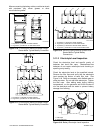
TP-6200 10/12 149Section 3 Scheduled Maintenance
5. Remove excess grease from the bearing pressure
relief ports.
6. Inspect the fan drive belt and replace if it is damaged
or worn. Check the fan belt tension using a poly
V-belt tension gauge and adjust the tension, if
necessary. See Figure 3-15.
7. Reinstall the belt guards using the original
hardware.
Generator Set Model
New Belt,
N(lbf.)
Used Belt*,
N(lbf.)
1200-2250 kW
2450--2890
(550--650)
1650--1910
(370--430)
* A belt is considered used after 50 hours of service.
Figure 3-15 Poly V-Belt Tension Specifications
8. Reconnect the generator set engine starting
battery(ies), negative (--) lead last.
9. Test run the generator set for a few minutes and
listen for belt noise (squeal) indicating a slipping
belt. Stop the generator set.
If the belt slips after the belt tension procedure, clean the
pulley surfaces and repeat the belt tension procedure. If
slippage continues, replace the fan belt.
3.11 Battery
Sulfuric acid in batteries.
Can cause severe injury or death.
Wear protective goggles and
clothing. Battery acid may cause
blindness and burn skin.
WARNING
Battery electrolyte is a diluted sulfuric acid. Battery acid
can cause severe injury or death. Battery acid can cause
blindness and burn skin. Always wear splashproof safety
goggles, rubber gloves, and boots when servicing the battery.
Do not open a sealed battery or mutilate the battery case. If
battery acid splashes in the eyes or on the skin, immediately
flush the affected area for 15 minutes with large quantities of
clean water. Seek immediate medical aid in the case of eye
contact. Never add acid to a batteryafter placing the battery in
service, as this may result in hazardous spattering of battery
acid.
Battery acid cleanup. Battery acid can cause severe
injury or death. Battery acid is electrically conductive and
corrosive. Add 500 g (1 lb.) of bicarbonate of soda (baking
soda) to a container with 4 L (1 gal.) of water and mix the
neutralizing solution. Pour the neutralizing solution on the
spilled battery acid and continue to add the neutralizing
solution to the spilled battery acid until all evidence of a
chemical reaction (foaming) has ceased. Flush the resulting
liquid with water and dry the area.
Battery gases. Explosion can cause severe injury or
death. Battery gases can cause an explosion. Do not smoke
or permit flames or sparks to occur near a battery at any time,
particularly when it is charging. Do not dispose of a battery in
a fire. To prevent burns and sparks that could cause an
explosion, avoid touching the battery terminals with tools or
other metal objects. Remove all jewelry before servicing the
equipment. Discharge static electricity from your body before
touching batteries by first touching a grounded metal surface
away from the battery. To avoid sparks, do not disturb the
battery charger connections while the battery is charging.
Always turn the battery charger off before disconnecting the
battery connections. Ventilate the compartments containing
batteries to prevent accumulation of explosive gases.
Battery short circuits. Explosion can cause severe injury
or death. Short circuits can cause bodily injury and/or
equipment damage. Disconnect the battery before generator
set installation or maintenance. Remove all jewelry before
servicing the equipment. Use tools with insulated handles.
Remove the negative (--) lead first when disconnecting the
battery. Reconnect the negative (--) lead last when
reconnecting the battery. Never connect the negative (--)
battery cable to the positive (+) connection terminal of the
starter solenoid. Do not test the battery condition by shorting
the terminals together.
Refer to this section for general battery information and
maintenance. All generator set models use a negative
ground with a 12-volt or 24-volt engine electrical system.
Consult the generator set nameplate for the engine
electrical system voltage. Consult the generator set
spec sheet for battery capacity recommendations for
replacement purposes. The wiring diagrams provide
battery connection information. See Figure 3-16,
Figure 3-17, and Figure 3-18 for typical battery
connections, including multiple battery configurations.
3.11.1 Clean Battery
Clean the battery and cables and tighten the battery
terminals according to the service schedule
recommendations. Clean the battery by wiping it with a
damp cloth. Keep the electrical connections dry and
tight.
If corrosion exists, disconnect the cables from the
battery and remove the corrosion with a wire brush.
Clean the battery and cables with a solution of baking
soda and water. Do not allow the cleaning solution to
enter battery cells. Flush the battery and cables with
clean water and wipe the battery with a dry cloth.


















